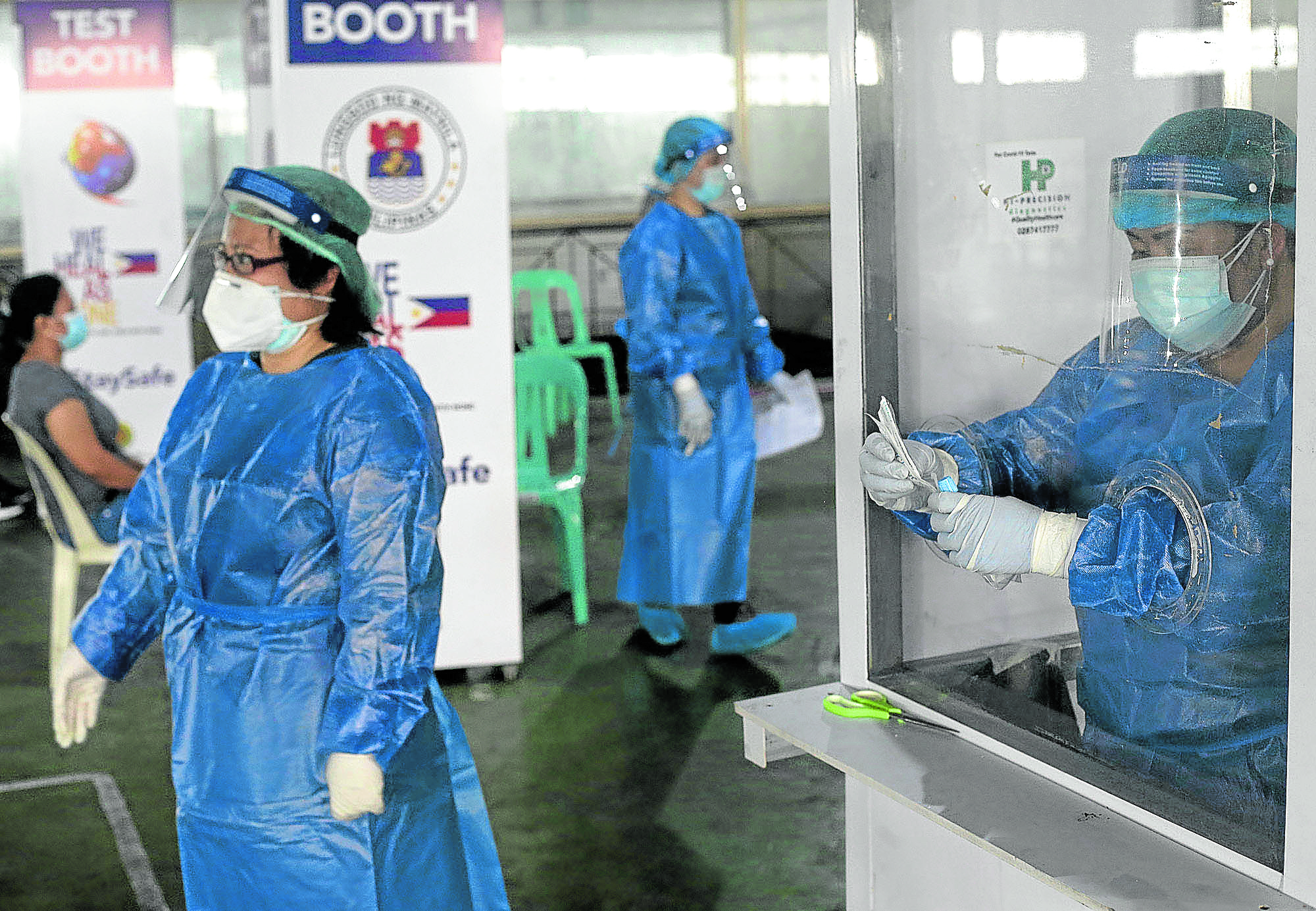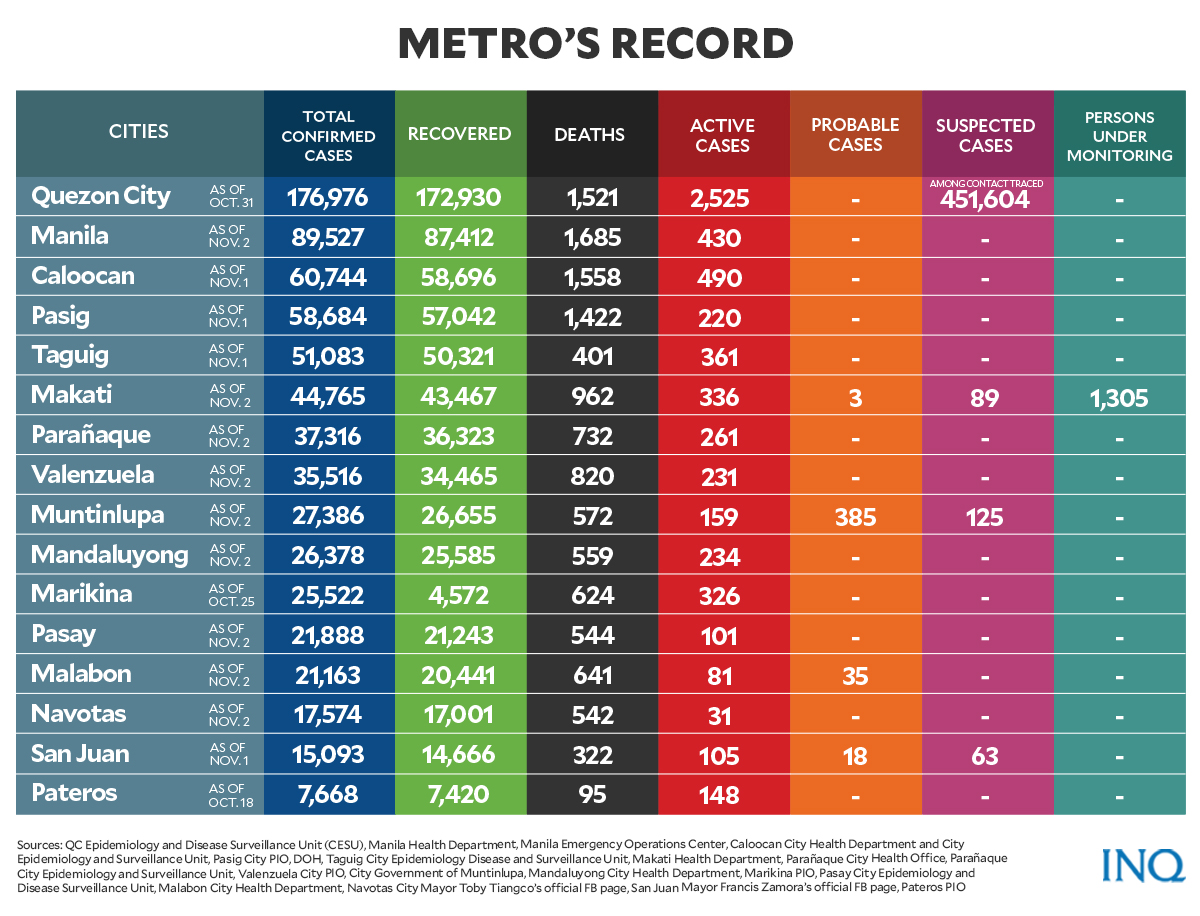What the numbers say before NCR shifts to Alert Level 2

DUTY AT HOME File photo shows health workers conducting free swab tests in Manila about a month before the easing of the deployment ban. —RICHARD A. REYES
MANILA, Philippines—Over two months after the government placed Metro Manila on COVID Alert Level 4, Malacañang announced that there was a “big possibility” for the capital region to ease to Alert Level 2 as the holidays draw near.
According to presidential spokesperson Harry Roque, Metro Manila might have more relaxed quarantine restrictions under Alert Level 2—if the region’s average daily attack rate (ADAR) for COVID reaches seven percent.
Currently, Metro Manila’s ADAR is at 7.7 percent.
“There is a big possibility it will go down,” Roque said.
READ: Palace: ‘Big possibility’ of easing NCR to COVID Alert Level 2 before holidays
Prior to the Palace statement, Presidential Adviser for Entrepreneurship Joey Concepcion has urged the Inter-Agency Task Force for the Management of Emerging Infectious Diseases (IATF) to downgrade the region to Alert Level 2 by Nov. 15.
READ: Shift to alert level 2 in Metro Manil by Nov. 15 urged
OCTA Research group also backed proposals to ease Metro Manila to a lower alert level as long as it was done in a “safe manner.”
READ: OCTA group backs easing NCR to Alert Level 2
As the government mulls on shifting Metro Manila to Alert Level 2, INQUIRER.net will present some sets of data on the current COVID-19 situation in each city of Metro Manila.
COVID-19 cases in NCR
The Department of Health (DOH) reported that as of Nov. 2, there were 2,792,656 confirmed cases of COVID-19 in the country.
At least 2,708,466 have already recovered, while 43,404 patients died.
At least 40,786 cases remained active nationwide.
READ: DOH logs only 2,303 new COVID cases amid low testing
The Department of Health (DOH) also said that Metro Manila is now under low-risk classification for COVID-19 transmission after the region logged 770 new daily cases from Oct. 26 to Nov. 1—around 14 percent lower than the average 898 cases recorded from Oct. 19-25.
Metro Manila’s ADAR also went down from 11.90 per 100,000 individuals from Oct.5 to 18 to 5.97 from Oct. 19 to Nov.1.
READ: NCR now ‘low risk’ for COVID-19 transmission; Region 2, CAR ‘moderate risk’
For a closer look at the situation in the cities of Metro Manila, below are the recent COVID-19 numbers recorded and released by the different local government units (LGUs) based on number of cases:

Graphic by Ed Lustan
Quezon City (as of Oct. 31)
Source: QC Epidemiology and Disease Surveillance Unit (CESU)
- Total confirmed cases: 176,976
- Recovered: 172,930
- Deaths: 1,521
- Active cases: 2,525
- Suspect case among contact traced: 451,604
Manila (as of Nov. 2)
Source: Manila Health Department, Manila Emergency Operations Center
- Total confirmed cases: 89,527
- Recovered: 87,412
- Deaths: 1,685
- Active cases: 430
Caloocan (as of Nov. 1)
Source: Caloocan City Health Department and City Epidemiology and Surveillance Unit
- Total confirmed cases: 60,744
- Recovered: 58,696
- Deaths: 1,558
- Active cases: 490
Pasig (as of Nov. 1)
Source: Pasig City PIO, DOH
- Total confirmed cases: 58,684
- Recovered: 57,042
- Deaths: 1,422
- Active cases: 220
Taguig (as of Nov. 1)
Source: Taguig City Epidemiology Disease and Surveillance Unit (CEDSU)
- Total confirmed cases: 51,083
- Recovered: 50,321
- Deaths: 401
- Active cases: 361
Makati (as Nov. 2)
Source: Makati Health Department (MHD)
- Total confirmed cases: 44,765
- Recovered: 43,467
- Deaths: 962
- Active cases: 336
- Probable cases: 3
- Suspected cases: 89
- Persons under monitoring: 1,305
Parañaque (as of Nov. 2)
Source: Parañaque City Health Office, Parañaque City Epidemiology and Surveillance Unit
- Total confirmed cases: 37,316
- Recovered: 36,323
- Deaths: 732
- Active cases: 261
Valenzuela (as of Nov. 2)
Source: Valenzuela City PIO
- Total confirmed cases: 35,516
- Recovered: 34,465
- Deaths: 820
- Active cases: 231
Muntinlupa (as of Nov. 2)
Source: City Government of Muntinlupa
- Total confirmed cases – 27,386
- Recovered: 26,655
- Deaths: 572
- Active cases: 159
- Probable cases: 385
- Suspected cases: 125
Mandaluyong (as of Nov. 2)
Source: Mandaluyong City Health Department
- Total confirmed cases: 26,378
- Recovered: 25,585
- Deaths: 559
- Active cases: 234
Marikina (as of October 25)
Source: Marikina PIO
- Total confirmed cases: 25,522
- Recovered: 4,572
- Deaths: 624
- Active cases: 326
Pasay (as of Nov. 2)
Source: Pasay City Epidemiology and Disease Surveillance Unit
- Total confirmed cases: 21,888
- Recovered: 21,243
- Deaths: 544
- Active cases: 101
Malabon (as of Nov. 2)
Source: Malabon City Health Department
- Total confirmed cases: 21,163
- Recovered: 20,441
- Deaths: 641
- Active cases: 81
- Probable cases: 35
Navotas (as of Nov. 2)
Source: Navotas City Mayor Toby Tiangco’s official Facebook page
- Total confirmed cases: 17,574
- Recovered: 17,001
- Deaths: 542
- Active cases: 31
San Juan (as Nov. 1)
Source: San Juan Mayor Francis Zamora’s official Facebook page
- Total confirmed cases – 15,093
- Recovered: 14,666
- Deaths: 322
- Active cases: 105
- Suspect cases: 63
- Probable cases: 18
Pateros (as of Oct. 18)
Source: Pateros PIO
- Total confirmed cases: 7,668
- Recovered: 7,420
- Deaths: 95
- Active cases: 148
According to analysis of data from DOH and OCTA on Nov. 1, all 17 Metro Manila local governments recorded a virus reproduction rate below 0.9.
This meant that all LGUs in NCR are seeing a downward trend in COVID-19 cases.
An R0 (pronounced as “r-naught”) indicates how infectious a disease is.
An R0 of 1 meant that an infected person can pass the virus to another person. If the R0 is less than 1, each existing infection would cause less than one new infection, which meant that the spread of the virus is on the decline.
The reproduction number in NCR was 0.53, according to OCTA Research fellow Dr. Guido David.
David also noted that the city of Navotas was “at very low risk,” with a reproduction number of 0.27.
It is followed by Pateros (0.42), Taguig (0.44), Caloocan (0.47), Pasay (0.47), Malabon (0.49), Quezon City (0.50), Marikina (0.50), and Parañaque (0.50).
Those with reproduction numbers above 0.50 were Muntinlupa (0.52), Pasig (0.56), Makati (0.58), Manila (0.59), Las Piñas (0.61), Mandaluyong (0.64), Valenzuela (0.67), and San Juan (0.71).
Vaccination updates
Aside from the downward trend in the region’s reproduction number, NCR was also able to vaccinate 88.13 percent of its target population as of Nov. 2.
Data from the National Vaccination Operations Center (NVOC) showed a total of 8,616,362 out of the target 9,776,356 individuals in Metro Manila have already received their full vaccine doses.
At least 9,441,847—or 96.58 percent—have already received their first vaccine dose.
A total of 18,058,209 vaccines were already administered in NCR, according to NVOC.
Several LGUs in Metro Manila have also released vaccination updates, including:
Caloocan (as of Nov. 1)
Source: Caloocan City Mayor Oscar Malapitan’s official Facebook page
- Total 1st dose: 920,787
- Total 2nd dose: 787,786
- Total vaccines deployed/administered: 1,708,573
Navotas (as of Nov. 2)
Souce: Navotas City Health Office
- Total 1st dose: 162,502
- Total 2nd dose: 147,963
- Total doses administered: 310,000
Quezon City (as of Nov. 2)
Source: Quezon City Government
- Partially vaccinated: 1,841,834
- Fully vaccinated: 1,767,406
- Total doses administered: 3,609,240
Taguig (as of Nov. 2)
Source: Taguig Vaccination Task Force
- Partially vaccinated: 668,110
- Fully vaccinated: 616,528
- Total doses administered: 1,268,791
Manila (as of October 29)
Source: Manila Health department, City Government of Manila
- Partially vaccinated: 1,387,305
- Fully vaccinated: 1,291,919
- Total doses administered: 2,640,412
Mandaluyong (as of Nov. 2)
Source: Mandaluyong City Health Office
- Partially vaccinated: 477,985
- Fully vaccinated: 436,696
- Total vaccines deployed/administered: 898,582
Pasay (as of Nov. 2)
Source: Pasay City PIO
- Partially vaccinated: 220,543
- Fully vaccinated: 254,306
- Total vaccines deployed/administered: 520,366
Las Piñas (as of October 23)
Source: Las Piñas PIO
- Partially vaccinated: 454,840
- Fully vaccinated: 423,478
- Total doses administered: 874,295
Muntinlupa (as of October 22)
Source: Muntinlupa City COVID-19 Vaccination Program (MunCoVac)
- Partially vaccinated: 353,490
- Fully vaccinated: 297,599
- Total vaccines administered: 646,730
No more curfew
Metropolitan Manila Development Authority (MMDA) Chair Benhur Abalos on Wednesday (Nov. 3), said that curfew—midnight to 4 a.m. currently—would be lifted on Thursday (Nov. 4).
“This will be on November 4 but subject to the ordinance of each LGUs in Metro Manila regarding minors because some of them have this ordinance that minors cannot just loiter around at a given time,” Abalos told INQUIRER.net
“We’re just respecting their prevailing ordinance on minors. Minors are still not allowed to go out but we just can’t say because maybe our alert levels will be changed,” he added.
In the House of Representatives, three congressmen—Anthony Peter Crisologo, Precious Hipolito Castelo and Allan Reyes—issued a statement on Tuesday (Nov. 2) saying they found the accumulated cases of COVID in Quezon City to still be quite high.
They said the number of cases in Metro Manila’s biggest city in terms of land area was higher than that in provinces—like Cavite, Laguna, Bulacan and Rizal—with big populations.
READ: NCR to lift curfew on November 4, subject to LGUs’ ordinances
In October, while Metro Manila was still on Alert Level 4 along with selected lockdowns, the Philippine National Police (PNP) reported a total of 274,231 quarantine violators in the region.
This was equivalent to at least 10,547 quarantine violators caught per day.
Of the sum, PNP said 192,000 violated minimum public health standards, while 2,815 were individuals who are not authorized to be outside of residence and 78,517 broke curfew.
Over the weekend, or during the celebration of All Saints’ Day, PNP recorded 166,277 quarantine violators in Metro Manila.
READ: More than 48K quarantine violators apprehended during Undas — PNP
DOH warning
While there have been improvements in the decline of COVID cases and progress in vaccination in Metro Manila, the DOH said the country’s active cases could still spike to 52,000 on Dec. 15.
This was premised on failure by the public to heed health protocol and on slower intervals between case detection and isolation as a result of increased mobility.
COVID-19 cases in Metro Manila may also shoot up to 3,535 by mid-December under those conditions.
Dr. Alethea De Guzman, acting director of the DOH Epidemiology Bureau, said increased mobility plus decline in adherence to health protocols plus slower detection and isolation of cases could push active cases to 49,000 to 52,000.
On the brighter side, if the current mobility level and the interval between detection to isolation is maintained, and the public continued to heed health protocols, the country might have only 2,100 active cases by Dec. 15 while Metro Manila might have 1,035 cases.
TSB
For more news about the novel coronavirus click here.
What you need to know about Coronavirus.
For more information on COVID-19, call the DOH Hotline: (02) 86517800 local 1149/1150.
The Inquirer Foundation supports our healthcare frontliners and is still accepting cash donations to be deposited at Banco de Oro (BDO) current account #007960018860 or donate through PayMaya using this link.